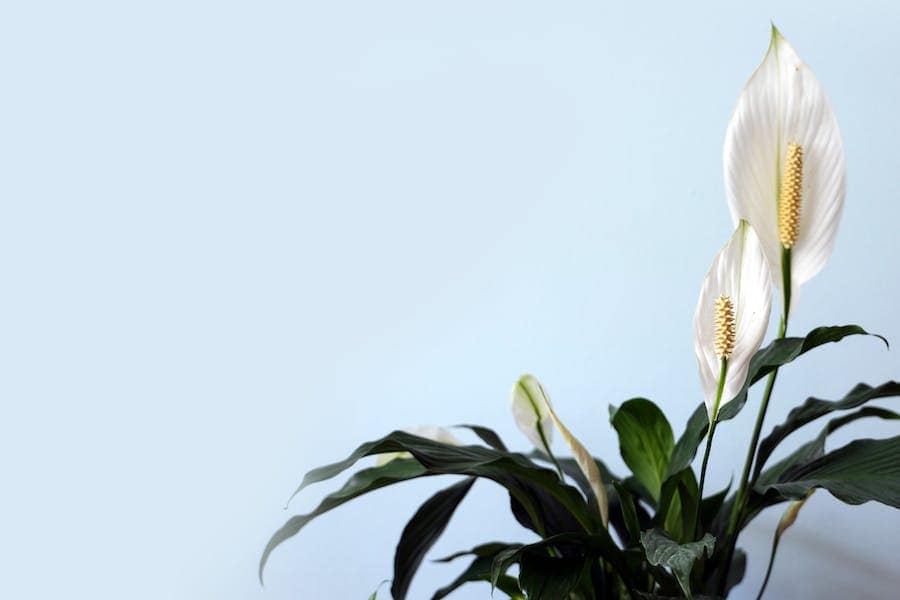The Peace Lily, scientifically known as Spathiphyllum, has long been a favorite choice among houseplant enthusiasts, not just for its lush green leaves but also for its elegant white flowers that bloom, seemingly to bring tranquility to any room. Its popularity, in many ways, is attributed to its forgiving nature and adaptability to various indoor conditions. Yet, even the most seasoned plant parents occasionally find themselves perplexed when the typically pristine white blossoms of their Peace Lily start adopting a hue of disconcerting brown. For those who take pride in their indoor gardening prowess, it’s somewhat akin to finding a cherished piece of artwork marred by an unexpected blemish. The sight often prompts immediate concern: Is it a sign of neglect, an indication of a lurking pest, or perhaps a symptom of an underlying disease? As you delve deeper into the realm of Peace Lily care, understanding why this browning occurs becomes crucial, not just for the aesthetics of the plant but also for its overall health. In this post, we’ll explore the various reasons behind this phenomenon and offer insights into how to address and prevent it.
Why Is My Peace Lily Flower Turning Brown?
Your Peace Lily’s flowers might be turning brown due to several reasons. Over-watering or under-watering is a common culprit. Ensure your plant isn’t sitting in water and that it’s potted in well-draining soil. Too much direct sunlight can also cause browning; Peace Lilies prefer indirect light. Other factors include over-fertilization, temperature fluctuations, and pests or diseases. Lastly, it’s natural for Peace Lily flowers to eventually age and turn brown over time. Ensure you’re following proper care guidelines, and consider trimming off the browned flowers to encourage new growth.
Main Causes Of Brown Flowers In Peace Lilies
Peace Lilies, with their glossy leaves and pristine white blooms, have been an indoor gardening favorite for years. However, when these usually vibrant flowers turn brown, it can leave many gardeners scratching their heads. Here’s a breakdown of the main causes:
- Watering Issues: Perhaps the most common reason for browning Peace Lily flowers is incorrect watering. Both over-watering and under-watering can have detrimental effects. Over-watered plants may develop root rot, which cuts off the essential nutrients and water supply to the flower, causing it to turn brown. On the other hand, under-watered Peace Lilies can become stressed, leading to browning flowers as a reaction to drought conditions. The key is to maintain a balanced watering routine, ensuring the soil remains moist but not waterlogged.
- Light And Temperature: Peace Lilies thrive in indirect sunlight. If they’re exposed to prolonged direct sunlight, their flowers can get sunburned, leading to a brownish discoloration. Similarly, abrupt temperature fluctuations, such as cold drafts or excessive heat, can stress the plant, leading to the browning of the flowers. To maintain their radiant blooms, keep Peace Lilies away from direct sunlight and in a room with stable temperatures.
- Soil And Fertilization: The quality of the soil and the amount of fertilization play pivotal roles in the health of a Peace Lily. Soil that doesn’t drain well can cause water to pool at the plant’s roots, which can be a precursor to root rot and subsequently brown flowers. Over-fertilization, on the other hand, can lead to a buildup of salts in the soil, burning the roots and depriving the flower of essential nutrients. Regularly flushing the soil and using a well-balanced fertilizer can help prevent these issues.
- Pests And Diseases: Various pests, such as mealybugs or spider mites, can infest Peace Lilies, sucking out their sap and causing stress, which can manifest as browning flowers. In addition to pests, fungal and bacterial infections can also compromise the health of the plant. Regularly inspecting your Peace Lily for signs of pests or disease can help catch problems early, allowing for more effective intervention.
- Environmental Stressors: Besides light and temperature, other environmental factors like humidity can impact the health of a Peace Lily. These plants prefer higher humidity levels. If the air is too dry, it can cause the flowers to brown. Keeping your plant in a humid environment or using a humidifier can mitigate this problem.
- Physical Damage: Accidentally brushing against the delicate blooms or dropping the plant can cause physical trauma, leading to browning. While accidents can happen, ensuring the plant is in a safe location away from high-traffic areas can minimize the risk of physical damage.
- Natural Aging Process: It’s essential to note that Peace Lilies, like all living organisms, go through a natural lifecycle. As the flowers age, it’s not uncommon for them to turn brown as they approach the end of their lifespan. This browning due to aging is natural and is a sign that the flower is ready to be pruned.
How Do I Keep My Peace Lily Flowers From Turning Brown?
Peace Lilies are widely celebrated for their stunning, pristine white flowers that exude tranquility and elegance. However, witnessing these typically vibrant blooms turning brown can be disheartening for many plant enthusiasts. If you find yourself facing this issue, understanding the potential causes and preventive measures can be the key to restoring and maintaining the plant’s health.
Watering Precision:
Proper watering is essential for peaceful lilies. Over-watering can result in root rot, which denies the flowers the nutrients they need while under-watering can leave the plant dehydrated and stressed. The trick is to maintain a balance. Make sure the soil is consistently moist but not waterlogged. A common practice is to water the plant when the top inch of soil feels dry to the touch. Ensure that the pot has adequate drainage to prevent water accumulation at the roots.
Optimal Light And Temperature:
Peace Lilies thrive best in indirect sunlight. Direct sunlight can scorch the delicate flowers, leading to a brown discoloration. If your plant is near a window, consider using sheer curtains to filter the sunlight or moving it to a shadier spot. Additionally, keep your Peace Lily away from drafts, vents, or areas with rapid temperature fluctuations. Ideally, these plants flourish in temperatures ranging from 65°F to 80°F.
Right Soil And Judicious Fertilization:
Using well-draining soil ensures that water doesn’t pool around the plant’s roots, reducing the risk of root rot. Regarding fertilization, while Peace Lilies aren’t heavy feeders, they do benefit from a balanced liquid fertilizer every 6-8 weeks during their growing season. However, avoid over-fertilizing as excess salts can accumulate in the soil, burning the roots and stressing the plant.
Pest Prevention And Disease Control:
Keep an eye out for common pests like spider mites and mealybugs, which can be detrimental to your Peace Lily’s health. Wiping the leaves with a soft cloth dampened with soapy water can deter these pests. Additionally, it’s wise to periodically inspect the plant for signs of fungal or bacterial infections. If you notice any symptoms, isolate the affected plant from others and treat it promptly with appropriate remedies.
Maintaining Humidity Levels:
Peace Lilies have a preference for higher humidity. Brown tips on the flowers can be a sign that the air is too dry. If you live in a region with dry air, consider placing the plant on a tray filled with pebbles and water, ensuring that the pot doesn’t touch the water. This increases the immediate humidity. Alternatively, using a room humidifier can be beneficial.
Protecting From Physical Damage:
The flowers of the Peace Lily are delicate. Keeping them away from high-traffic areas or spots where they might be accidentally brushed against or knocked over can prevent physical damage. This is especially crucial if you have pets or young children.
Pruning And Care:
It’s essential to remember that Peace Lily flowers will naturally age and turn brown over time. When this happens, it’s an indication that the flower has run its course and is ready to be pruned. Regularly pruning old flowers encourages the growth of new ones. Additionally, remove any yellow or brown leaves to ensure the plant’s energy is directed towards healthier growth.
Monitoring Soil Ph:
Peace Lilies prefer slightly acidic to neutral pH levels, typically between 6.5 to 7.5. Occasionally checking the soil pH and making necessary adjustments can help in maintaining the plant’s health. If the pH is too high or too low, it can interfere with nutrient absorption, leading to stressed plants and brown flowers.
What Kind Of Fertilizer Do Peace Lilies Need?
Peace Lilies, known scientifically as Spathiphyllum, are cherished for their ability to thrive even in less-than-ideal indoor conditions. However, to ensure they exhibit lush green foliage and those signature serene white blooms, providing them with the right nutrition is essential. This is where fertilizers play a pivotal role. The best fertilizer for Peace Lilies is a balanced, water-soluble fertilizer with an equal ratio of nitrogen, phosphorus, and potassium. A popular choice is a 20-20-20 formulation. Here’s a deeper dive into what each component offers:
- Nitrogen (N): Essential for leaf growth and overall plant vitality. It promotes the lush green appearance of the Peace Lily.
- Phosphorus (P): Vital for flower and root development. Ensuring adequate phosphorus helps in producing those characteristic white spathes.
- Potassium (K): Supports the overall health, strength, and resistance of the plant.
Conclusion
The allure of the Peace Lily lies in its lush foliage and pristine white blooms, making it a cherished addition to countless homes and offices. So, when its elegant flowers turn brown, it’s naturally a matter of concern for plant enthusiasts. While several factors, ranging from watering habits and light conditions to pests and natural aging, can contribute to this discoloration, the good news is that most of these issues are addressable. By understanding the root causes and implementing timely corrective actions, one can not only restore the Peace Lily to its original splendor but also prevent future browning. Above all, regular observation and a commitment to its care ensure that this beautiful plant remains a symbol of peace and tranquility in its surroundings.
FAQ’s
Should You Cut Brown Flowers Off Peace Lily?
Yes, you should cut brown flowers off a Peace Lily. Removing the browned flowers can improve the plant’s appearance and encourage new growth. Use sterilized scissors or pruning shears and cut the flower stem close to the base, ensuring you don’t damage any surrounding leaves or stems.
How Long Do Peace Lily Flowers Last?
Peace Lily flowers typically last for several weeks, depending on the plant’s health and environmental conditions. Once the bloom completes its lifecycle, it will naturally start to fade and turn brown. However, with proper care, a Peace Lily can produce flowers multiple times a year.
Can You Start A New Plant From A Peace Lily?
Yes, you can start a new plant from a Peace Lily. The most common method is through division. Mature Peace Lilies can be divided into smaller plants, especially if they’ve outgrown their pot. To do this, gently remove the plant from its pot, separate the root clusters into smaller sections, ensuring each section has both roots and foliage, and replant in fresh potting soil. This not only gives you new plants but also rejuvenates the parent plant, promoting healthier growth.




















Leave a Reply